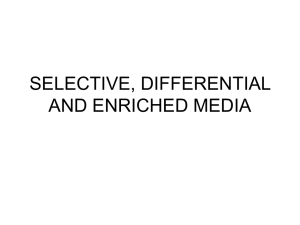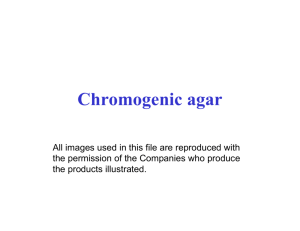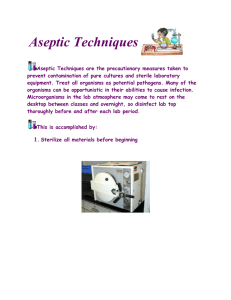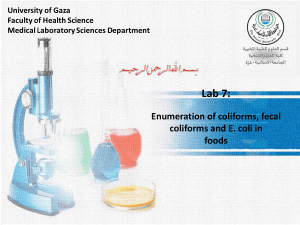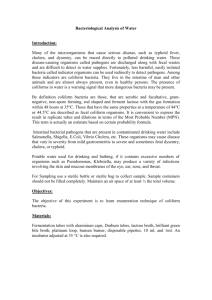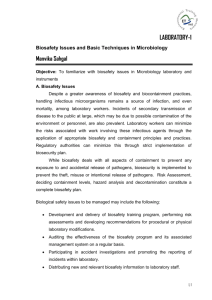BACTERIAL EXAMINATION OF WATER
advertisement
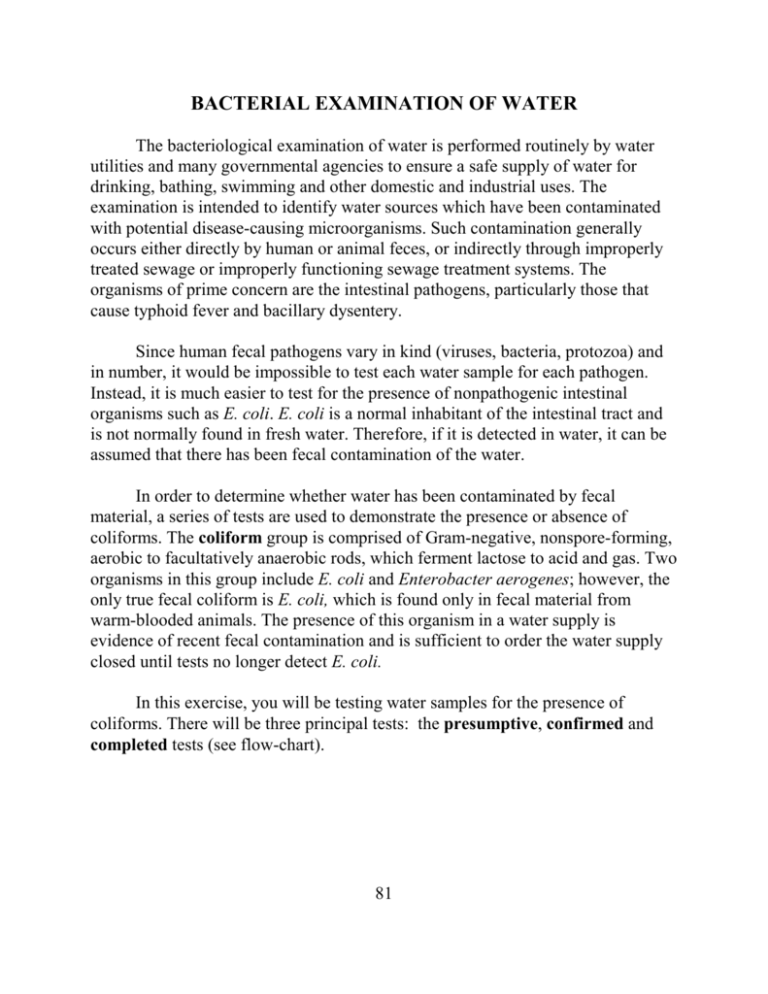
BACTERIAL EXAMINATION OF WATER The bacteriological examination of water is performed routinely by water utilities and many governmental agencies to ensure a safe supply of water for drinking, bathing, swimming and other domestic and industrial uses. The examination is intended to identify water sources which have been contaminated with potential disease-causing microorganisms. Such contamination generally occurs either directly by human or animal feces, or indirectly through improperly treated sewage or improperly functioning sewage treatment systems. The organisms of prime concern are the intestinal pathogens, particularly those that cause typhoid fever and bacillary dysentery. Since human fecal pathogens vary in kind (viruses, bacteria, protozoa) and in number, it would be impossible to test each water sample for each pathogen. Instead, it is much easier to test for the presence of nonpathogenic intestinal organisms such as E. coli. E. coli is a normal inhabitant of the intestinal tract and is not normally found in fresh water. Therefore, if it is detected in water, it can be assumed that there has been fecal contamination of the water. In order to determine whether water has been contaminated by fecal material, a series of tests are used to demonstrate the presence or absence of coliforms. The coliform group is comprised of Gram-negative, nonspore-forming, aerobic to facultatively anaerobic rods, which ferment lactose to acid and gas. Two organisms in this group include E. coli and Enterobacter aerogenes; however, the only true fecal coliform is E. coli, which is found only in fecal material from warm-blooded animals. The presence of this organism in a water supply is evidence of recent fecal contamination and is sufficient to order the water supply closed until tests no longer detect E. coli. In this exercise, you will be testing water samples for the presence of coliforms. There will be three principal tests: the presumptive, confirmed and completed tests (see flow-chart). 81 STANDARD WATER ANALYSIS The Presumptive Test In the presumptive test, a series of lactose broth tubes are inoculated with measured amounts of the water sample to be tested. The series of tubes may consist of three or four groups of three, five or more tubes. The more tubes utilized, the more sensitive the test. Gas production in any one of the tubes is presumptive evidence of the presence of coliforms. The most probable number (MPN) of coliforms in 100 ml of the water sample can be estimated by the number of positive tubes (see MPN Table). The Confirmed Test If any of the tubes inoculated with the water sample produce gas, the water is presumed to be unsafe. However, it is possible that the formation of gas may not be due to the presence of coliforms. In order the confirm the presence of coliforms, it is necessary to inoculate EMB (eosin methylene blue) agar plates from a positive presumptive tube. The methylene blue in EMB agar inhibits Grampositive organisms and allows the Gram-negative coliforms to grow. Coliforms produce colonies with dark centers. E. coli and E. aerogenes can be distinguished from one another by the size and color of the colonies. E. coli colonies are small and have a green metallic sheen, whereas E. aerogenes forms large pinkish colonies. If only E. coli or if both E. coli and E. aerogenes appear on the EMB plate, the test is considered positive. If only E. aerogenes appears on the EMB plate, the test is considered negative. The reasons for these interpretations are that, as previously stated, E. coli is an indicator of fecal contamination, since it is not normally found in water or soil, whereas E. aerogenes is widely distributed in nature outside of the intestinal tract. The Completed Test The completed test is made using the organisms which grew on the confirmed test media. These organisms are used to inoculate a nutrient agar slant and a tube of lactose broth. After 24 hours at 37°C, the lactose broth is checked for the production of gas, and a Gram stain is made from organisms on the nutrient agar slant. If the organism is a Gram-negative, nonspore-forming rod and produces gas in the lactose tube, then it is positive that coliforms are present in the water sample. 82 FIRST PERIOD Material: 1. Nine tubes of double-strength lactose broth 2. 10, 1.0 and 0.1 ml pipets 3. Water samples Procedure: (work in groups of four) Presumptive Test 1. Take a water sample (dilute as instructed in some cases) and inoculate three tubes of lactose broth with 10 ml, three tubes with 1.0 ml and three tubes with 0.1 ml. 2. Incubate all tubes at 37oC for 24 hours. SECOND PERIOD Material: 1. EMB agar plates Procedure: Presumptive Test 1. Observe the number of tubes at each dilution that show gas production in 24 hrs. Record results. 2. Reincubate for an additional 24 hours at 37°C. Confirmed Test 1. Inoculate an EMB plate with material from a tube containing gas. 2. Invert and incubate the plate at 37°C for 24 hours. 83 THIRD PERIOD Material: 1. Lactose broth tubes 2. Nutrient agar slants Procedure: Presumptive Test 1. Observe the number of tubes at each dilution that show gas. Record results and determine the most probable number index. Confirmed Test 1. Observe EMB agar plates. A positive confirmed test is indicated by small colonies with dark centers and a green metallic sheen (E. coli). Record results. Completed Test 1. Inoculate a lactose broth tube and a nutrient agar slant with organisms from the EMB plate. 2. Incubate the broth tube and agar slant at 37°C for 24 hours. FOURTH PERIOD Procedure: Completed Test 1. Check for gas production in the lactose broth tube. 2. Make a Gram stain from the organisms on the nutrient agar slant. 3. Record results. 84 FOOD MICROBIOLOGY The presence of microorganisms in food is beneficial in some cases and harmful in other cases. Certain microorganisms are necessary in preparing foods such as cheese, pickles, sauerkraut, yogurt and sausage. Other microorganisms, however, may be responsible for serious and sometimes fatal food poisoning and toxicity as well as food spoilage (the product smells, looks, or tastes bad). Microbial spoilage of any food depends on the chemical composition of the food and the types of organisms with which the food comes into contact. Consider a fresh Granny Smith apple containing a high percentage of carbohydrates. If a carbohydrate-fermenting organism came in contact with the inner tissue of the apple, the organism would survive, multiply, produce acid and gas (maybe alcohol), and, at the same time, destroy the tastiness of the apple. If a proteolytic or lipolytic organism came in contact with the same apple, the microorganism may not survive for long because of the non-availability of protein or lipids, and also because of the low pH of the apple tissue. Two physical factors involved in the rate of food spoilage are the manner in which the food is processed and the method used to preserve the food. These include cooking, salting, drying, adding microbial inhibitors, adding sugar, canning, refrigerating, freezing and irradiating. FIRST PERIOD Material: 1. Samples of fresh raw hamburger, raw chicken, chicken salad, oysters, fresh unwashed vegetables, fresh unwashed fruits, dried fruits, cottage cheese, or creamy salad dressings 2. One 90-ml dilution bottle of sterile saline 3. Four 9-ml dilution tubes of sterile saline 4. Five nutrient agar plates 5. 1.0 and 0.1 ml pipets 6. Glass spreader 7. 95% ethyl alcohol in glass beaker 87 Procedure: (work in groups of four) 1. Add 10 g of the food product to be assayed into a Waring blender jar. Add 90 ml of sterile saline and blend the mixture at high speed until a uniform slurry is formed (approximately 1 to 3 minutes). You will have made a 10-1 dilution of the food sample. 2. Prepare serial dilutions (10-2, 10-3, 10-4, 10-5) by transferring 1.0 ml at each step. Be sure to mix the diluted samples before each serial transfer. 3. Transfer 0.1 ml of each of the dilutions onto nutrient agar plates. 4. Incubate all plates in an inverted position for 2 days at 37°C. SECOND PERIOD Material: 1. Colony counter Procedure: 1. Count the number of colonies on each plate and record. Results: Type of Food PLATE Number of Colonies 10-2 10-3 10-4 10-5 10-6 88 Number of Organisms per ml THE CHROMOGENIC SUBSTRATE TEST Simple one-step defined substrate tests for detecting coliforms are now available. These tests are designed to detect the presence or absence of coliform bacteria and to indicate specifically the presence or absence of E. coli. The Colilert® system is one example of a P-A (presence-absence) test. A water sample is added to a special medium containing ONPG (o-nitrophenyl--D-galactopyranoside) and MUG (4-methylumbelliferyl--D-glucuronide). These substrates are the major sources of carbon in Colilert®. ONPG is hydrolyzed by -galactosidase, the enzme that cleaves lactose to glucose and galactose. The medium will turn yellow if coliforms, which have the ability to ferment lactose, are present. E. coli uses another enzyme, -glucoronidase, to metabolize MUG. The modified MUG yields a fluorescent product that can be seen under long-wavelength ultraviolet light. Non-target organisms, i.e. non-coliforms, are both starved and suppressed in the Colilert® medium. Refer to the attached AWWA report for more information. FIRST PERIOD 1. Add 100 ml of the water sample to a sterile, transparent, non-fluorescent bottle provided by Colilert®. 2. Tap one of the "snap packs" to ensure that all of the Colilert® reagents are in the bottom part of the pack. Pour contents of "snap pack" into the water sample. Cap and seal the bottle, and shake until the Colilert® reagents have dissolved. 3. Incubate the bottle for 24 hours at 35°C. 89 SECOND PERIOD 1. Read the results at 24 hours. Compare each result against the "comparator" provided by Colilert®. L If no yellow color is observed, the test is negative. L If the sample has a yellow color equal to or greater than the "comparator", the presence of coliforms of confirmed. L If the sample is yellow, but lighter than the "comparator", incubate for 4 more hours (but no more than 28 hours total). If coliforms are present, the color will intensify. If the color does not intensify, coliforms are absent. L If the sample developed a yellow color, check for fluorescence. If fluorescence is greater to or equal to the fluorescence of the "comparator", the presence of E. coli is confirmed. 90

